Description
Oolong from Wuyi Mountains, Fujian Province, China. Thanks to an extremely favorable growing environment, “Dahongpao” seed trees produce tea leaves in a unique way.
Nutritional declaration per 100 ml:
Ενέργεια >0,1 g kJ/ >0,1 kcal.
Fat <0,1 g of which are saturated <0,1 g.
Carbohydrates <0,1 g of which sugars <0,1 g.
Proteins <0,1 g.
Salt <0,1 g.
Tea type: Oolong
Area: Wuyi Mountain range, Fujian Province, China.
Average altitude: about 650m
Harvest time: from April to May
In the Chinese tea culture of thousands of years, Wuyi rock tea is absolutely not ignored. The most valuable tea in Wuyi rock tea is Da Hong Pao. Known as the “King of Tea”. It can be considered as a national treasure.
Da Hong Pao translates in English as Big Red Robe.
The seed/mother trees, with only six surviving today, are more than 340 years old. They grow on the mountainside where a terrace has been built along the terrain.
Richard Nixon, the first US President to visit China in 1972, met Chairman Mao during his visit to China. During the meeting, the chairman gave Nixon 200g of Wuyi Da Hong Pao, Nixon was unhappy, felt that Mao Zedong as the leader of a big country in the East, should not be stingy.
Chinese Prime Minister Zhou Enlai, who was at Mao’s side, sensed Nixon’s confusion and immediately stepped forward to explain: Mr. President, the chairman has given you half the country. Nixon was more puzzled. What was going on? So, Zhou Enlai pointed to the exquisite jar of Da Hong Pao, said to President Nixon: Mr. President, Wuyi Da Hong Pao is the royal tribute of the Past dynasties in China, it only produces 400g a year, the chairman gave you 200g, just “half of the country”. Nixon found it humorous, and everyone laughed.
In 2003, the Government of Wuyishan city signed an insurance policy to insure 6 mother trees in the form of product liability insurance of CNY 100 million.
Picking mother trees was banned in 2006, and they are no longer available on the market. All the Da Hong Pao on sale today are cuttage breeding from mother trees.
Thanks to an exceptionally favorable growing environment, the “Dahongpao” seed trees produce tea leaves with a unique surprising medicial effect (The sunshine duration is short, the light reflection is more, the temperature difference between day and night is large, the rock top has clear water to moisten the soil all year round).
There are also numerous versions of folklore about “Dahongpao”, which have been passed down from a long time ago.
In 1385, A man named Ding Xian went to the capital for an examination. He suddenly fell ill while passing Wuyi mountain. At that time, he happened to meet a monk of Tianxin Yongle temple. The monk took some tea from his collection and drank it with Ding Xian. Then his pain gradually disappeared. . In the end he got cleared in the capital royal examination. He went back to thank the monk. The monk said it was not him who saved Ding Xian, but the tea, and told him to cover the tea tree with his red robe as a token of gratitude. The story of Da Hong Pao has since spread like wildfire.


















